
The interest in binary options trading is caused by their high profitability. This financial instrument attracts with its accessibility and the possibility of making a quick profit. People from different fields — from office workers to experienced entrepreneurs — strive to master binary options in search of additional income. However, due to the high volatility of the markets and the limited expiration time, binary options require traders not only to be attentive, but also to have a deep understanding of the processes.
One of the key tools that helps traders minimize mistakes and increase their chances of success is trading signals. They allow you to reduce the burden of analyzing the market and help you focus on decision-making. On the Pocket Option platform, users can use both embedded signals and third-party resources, which makes trading more convenient and efficient.

Pocket Option is a modern platform that was launched in 2017. Today, it offers access to a variety of financial assets, including currency pairs, indices, commodities, and cryptocurrencies. The platform stands out for its simple interface, a variety of training materials and high-quality technical support, which makes it suitable for both beginners and experienced traders.
What are trading signals?
Trading signals are recommendations based on in—depth market analysis that help traders make decisions about buying or selling assets. Such signals can be created manually by professional traders or automatically using special algorithms.

Why are they needed? In binary options, where every second can affect the outcome of a trade, having clear information about the market situation can significantly reduce risks. Signals help:
- Save time by eliminating the need for detailed analysis.
- Снизить влияние эмоций на процесс принятия решений.
- Increase the accuracy of forecasts, especially for traders with minimal experience.
Principles of operation of signals:
- Market analysis. The signals are based on a combination of technical indicators and chart analysis.
- News accounting. Economic and political events, such as unemployment reports or central bank decisions, can affect asset values.
- Making recommendations. For example, the signal may sound like this: “Buy the USD/EUR currency pair if the price rises above 1.20.”
How trading signals are created
Creating trading signals is a complex process that combines modern technology and expert opinion.
Technical analysis
The basis for most signals is technical analysis. It involves studying historical data, charts, and indicators such as the RSI, MACD, or Bollinger Bands. For example, when using Bollinger Bands, a signal can be generated when the price reaches the upper limit of the band, which indicates a possible decline.
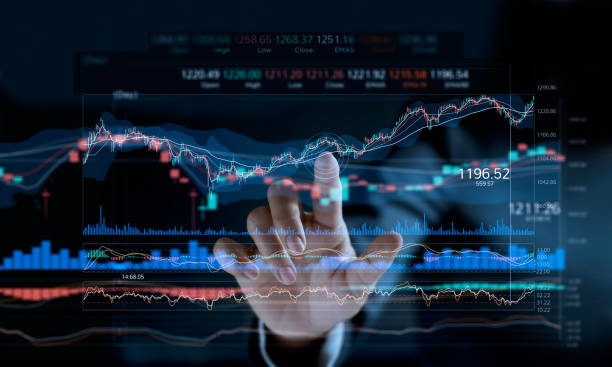
Fundamental analysis
Market sentiment is shaped by macroeconomic factors such as reports on GDP, interest rates, or political events. For example, an unexpected rate hike by the US Federal Reserve may trigger a rise in the dollar, which becomes a signal to open deals.
Example of creating a signalLet’s imagine that a trader analyzes a gold chart. He notes that the price has tested the resistance level of $1,950 per ounce several times. Based on this, a signal is formed: “At the breakdown of the $ 1950 level, open an upward trade with a target of $1970.” This approach is based on understanding market dynamics and using analysis tools.
Types of Pocket Option signals
Paid and free signals- Paid signals offer a higher level of accuracy because they are created by professional analysts. Such services are often accompanied by additional training materials, which makes them useful for traders who are ready to invest in their development.
- Free signals are available on the Pocket Option platform itself, as well as through various online communities. Despite their availability, their quality may be less stable.
- Manual signals are generated by professional traders who take into account a wide range of market factors. They are more flexible, but require more time.
- Automatic signals are generated by algorithms based on predefined rules. Their advantage is high speed and lack of human factors.
Example: an automatic signal may suggest opening a deal to raise Apple shares if their price breaks through the 200-day moving average.
Examples of signals for popular assets- Currency pairs: “EUR/USD: buy when the 1.1000 level is reached.”
- Cryptocurrencies: “Bitcoin: sale if the price drops below $95,000.”
- Commodities: “Oil: purchase when reaching $80 per barrel.”
How to use signals on Pocket Option
A step-by-step guide for beginners- Log in to your Pocket Option account.
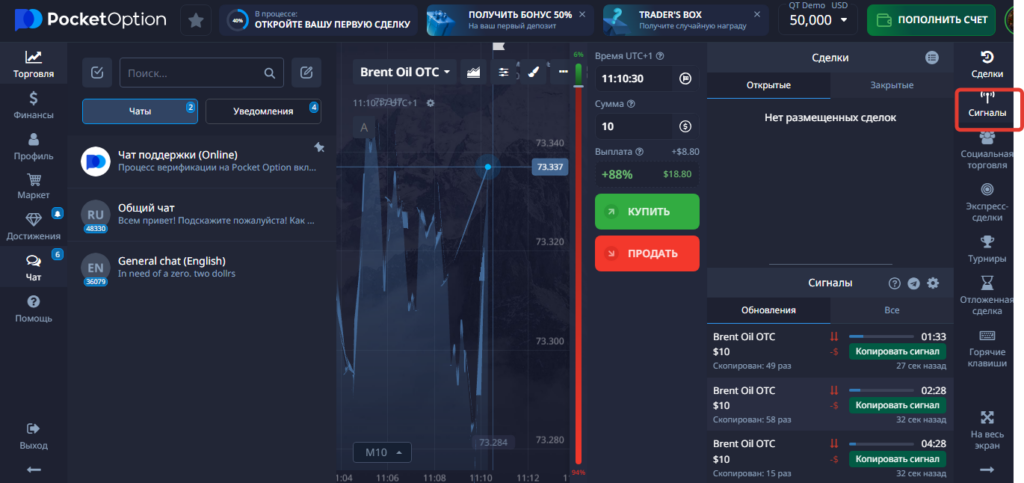
- Open the Signals section or connect a third-party service.
- Select the asset and time interval you are interested in.

- Follow the recommendations by specifying the required amount and the direction of the transaction.
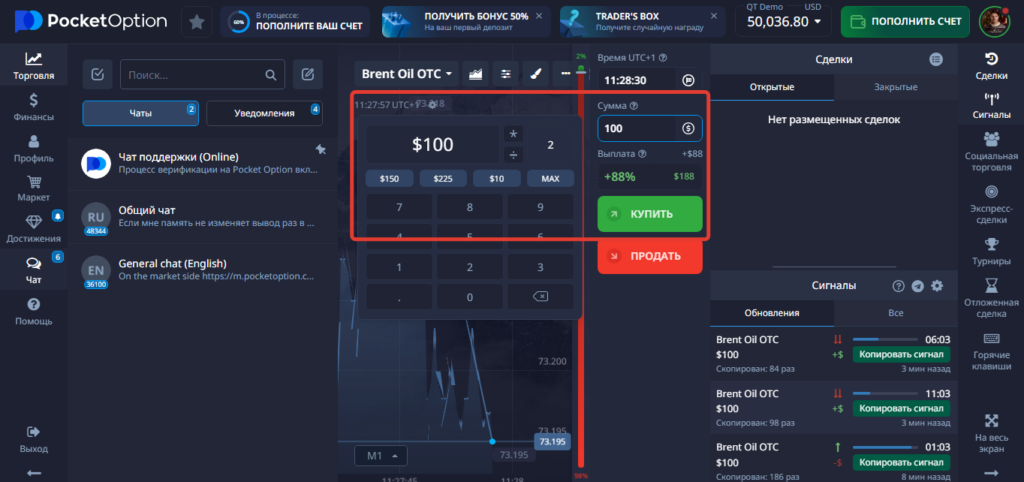
- Set up notifications to receive real-time alerts.
- Test the signals on a demo account before using real funds.
- Avoid trading during important news unless you are sure of the accuracy of the forecast.
A signal of an increase in the value of gold: a trader opens a trade for $ 100 with an expiration of 1 hour, which brings a return of 80% with a successful forecast.
After receiving a signal of a fall in the value of the euro against the dollar, the trader uses a short expiration to record a quick result.
Technical analysis for signal generation
Technical analysis is the basis of successful trading, including for working with binary options. This method is based on the study of charts and indicators that help identify patterns in price movements.
The main indicators and their significance
Indicators are a kind of compass for a trader. They help you navigate the market situation and form the basis for trading signals. Here are some popular tools:
- MACD (Moving Average Convergence Divergence). This indicator shows trend changes and helps determine the entry points of a trade. For example, if the MACD lines intersect, it signals a change in trend direction.
- RSI (Relative Strength Index). The indicator measures the strength of a trend and indicates overbought or oversold conditions of an asset. Values above 70 indicate overbought, and below 30 indicate oversold.
- Bollinger Bands. This tool helps you assess market volatility. If the price is approaching the upper limit of the bands, it is likely to decrease soon, and vice versa.
Using support and resistance levels
Support and resistance levels are key markers on the chart that show where the price may slow down or reverse. Support is a level below which the price rarely falls. Resistance is a mark above which the price rises with difficulty.

Example: Suppose an asset is trading in the range of $50 to $60. If the price is approaching $50, the trader may consider opening an upward trade, expecting that the support level will hold the price.
Examples of analysis on the platformOn the Pocket Option platform, traders can use the built-in technical analysis tools. For example, by setting up a chart with the RSI indicator and support levels, you noticed that the asset price tested the $100 level several times and bounced back each time. This is a signal that the level is a strong support, and an upward trade can be considered.
The impact of news on signals
Fundamental events such as economic reports or political changes can significantly affect price movements. That is why successful traders closely follow the news.
The role of the economic calendar
An economic calendar is a tool that shows planned events, such as the publication of data on GDP, unemployment, or changes in interest rates. This data helps traders predict market volatility and adapt their strategies in a timely manner.
How to integrate news into trading
To use the news effectively:
- Keep track of the economic calendar on the platform.
- Analyze the market’s reaction to past events.
- Combine news with technical analysis. For example, if the data confirms the signal from the MACD, the probability of a successful trade increases.
Examples of the impact of news on assets
Example: the publication of data on unexpected employment growth in the United States may cause a strengthening of the dollar. At this point, the signals may indicate the purchase of USD paired with a weaker currency, for example, the JPY.
Another example: OPEC’s announcement of a reduction in oil production causes an increase in oil prices. After receiving such a signal, the trader can open a deal to increase.
Signals for indexes
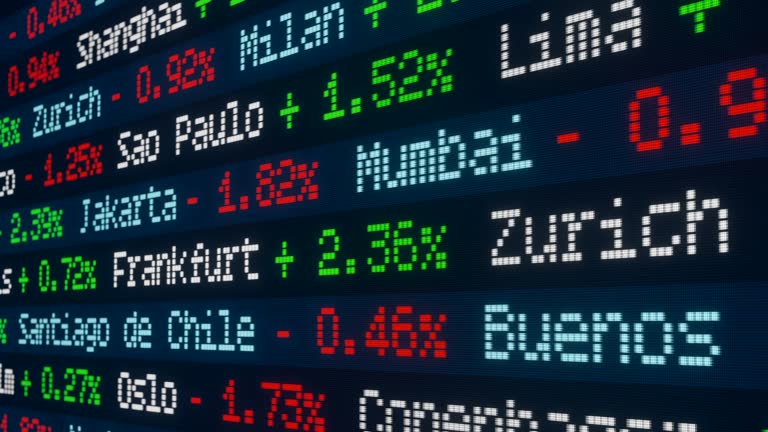
Indexes are baskets of assets that reflect the state of a particular sector of the economy. Examples: S&P 500, DAX, Nikkei 225.
Features of signals for indexesThe signals for the indices take into account macroeconomic factors such as interest rate changes, corporate reports, and general economic dynamics. For example, an increase in corporate profits may be a signal for an increase in the S&P 500 index.
Examples of using signals for indexes on Pocket OptionLet’s imagine that the signal indicates an increase in the DAX index, based on positive data on the growth of industrial production in Germany. A trader can open an upside trade with a short expiration, expecting the market to react immediately.
Forex Signals
The Forex market is characterized by high liquidity and volatility, which makes it ideal for working with signals.
Advantages of using signals in the Forex market
- High liquidity. Traders can enter and exit trades without delay.
- A wide range of assets. You can work with various currency pairs: from majors to exotic ones.
- Reaction to fundamental factors. Forex actively reacts to the news, which makes fundamental analysis especially important.
Example: There is a sell signal for GBP/USD on the market. The analysis shows that the Bank of England did not change the interest rate, which disappointed investors. Traders open sales deals, expecting a decrease in the exchange rate.
Signals for goods
Commodity assets such as gold, oil, or agricultural products are often affected by seasonal factors and global events.
The role of signals in commodity tradingThe signals help to take into account factors such as changes in supply and demand, weather conditions, or political instability.
Examples of signals for gold, oil, and other assetsExample: the signal indicates the purchase of gold, based on data on rising inflation in the United States. Investors use gold as a protective asset, which causes its price to rise.
Another example: a report of disruptions in oil supplies from the Middle East causes a sharp rise in prices. Traders receive a buy signal and open short-expiration trades to capitalize on the volatility.
Accurate signals: do they exist?
Many traders wonder if there are signals with perfect accuracy. In reality, it is impossible to achieve 100% accuracy, since the financial asset market is influenced by many factors, including sudden changes in the news background and the behavior of major players.
However, there are signals with a high probability of success. Their accuracy depends on the following factors:
- The quality of the analysis. Professionally created signals based on deep market research have a higher level of reliability.
- Time interval. Short-term signals are more sensitive to market fluctuations than long-term ones.
- The source of the signal. Using proven resources such as Pocket Option or the Trading Academy minimizes the risk of errors.
It is important to always check the source of the signals, especially if they are received from open Internet sources. A reliable signal is always accompanied by justification and recommendations for its use.
Tips for safe trading with signals
Working with trading signals requires care and responsibility. To avoid typical mistakes, the following recommendations should be followed:
- Testing on a demo account. Before using real funds, test the signals to understand their reliability and adapt them to your strategy.
- Money management. Never risk more than 2-5% of your deposit per trade to minimize potential losses.
- Avoid emotional trading. Follow the signals without panic and overconfidence. Trading on emotions often leads to mistakes.
A real example of successful trading: a trader received a signal to buy gold with an expiration of 1 hour. After analyzing the support level, he decided to invest 3% of his deposit. The deal made a profit, which strengthened confidence in the signal and helped to improve the trading strategy.
Where can I find proven signals?

For successful trading, it is important to use signals from reliable sources. Here are a few options:
- Official Pocket Option resources. The platform provides built-in signals that are suitable for both beginners and experienced traders.
- Analytical platforms. Resources such as the Trading Academy offer professional signals accompanied by detailed analysis.
- Recommendations of traders. Experienced traders often share their signals in specialized communities. However, it is important to verify the validity of such recommendations.
Using proven signals, traders can significantly increase their efficiency and minimize risks. The main thing is to approach trading responsibly and not rely on just one source of information.
Trading Academy: the Path to Financial independence
The Trading Academy is a unique educational project aimed at helping anyone who wants to master the intricacies of trading and start making money in the financial markets. The Academy offers a wide range of services, from teaching basic trading principles to providing proven trading signals and participating in an elite VIP club.
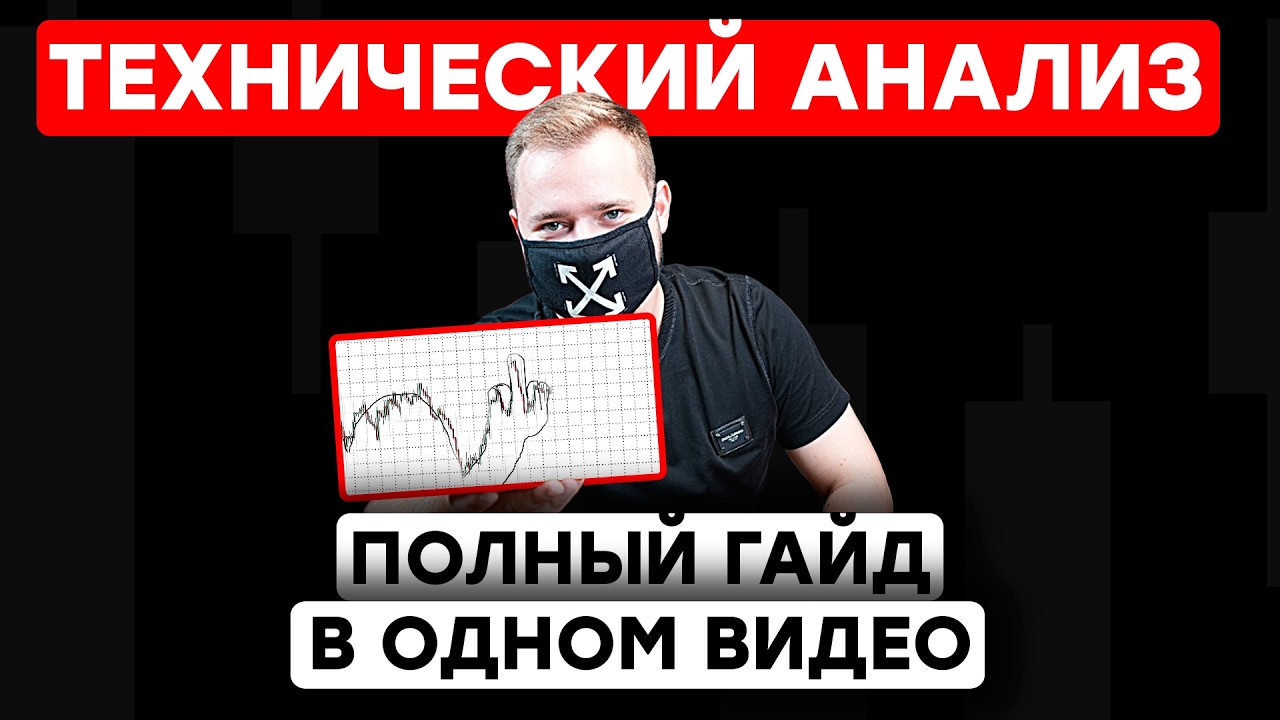
What does the Trading Academy do?
The Academy provides access to educational materials that are suitable for both beginners and experienced traders. Among the main directions:
- Trading training. Video tutorials, webinars, articles, and step-by-step guides help you master the basics of market analysis and trading strategies.
- Trading signals. The Academy has developed a system that helps to find entry and exit points based on the analysis of professional traders. Each signal is carefully checked and adapted to different trading styles.
- VIP club. This is a closed community where members get access to exclusive signals, personal advice, and expert recommendations. The club helps to optimize trading and increase its profitability.
Sure signs of success
The Academy pays special attention to the quality of its work. An important indicator is the high accuracy of the signals provided and the satisfied customer reviews. Many students note that thanks to the Academy they were able to achieve a stable income, avoid common mistakes and learn how to analyze the market on their own.
An example from the review: “At first I was skeptical, but after a month of working with the Academy, I realized how important knowledge and proper support are. Signals are always accurate, and analyzing trades allows you to learn from practice.”
Why choose the Trading Academy?
- Transparency and openness. The Academy publishes its results, shares strategies, and actively communicates with clients.
- Verified signals. Every sentence is carefully checked to eliminate errors.
- Learning flexibility. The materials are suitable for people with different levels of training.
- Long-term support. The Academy’s team is always in touch to answer questions and help solve difficult situations.
What is the VIP Club of the Trading Academy?
The VIP Club is an elite community where traders are provided with:
- Exclusive trading signals with increased accuracy.
- Personal consultations and deal reviews.
- The opportunity to participate in closed webinars and trainings.
Club members get access to unique information that is not available to a wide audience. This significantly increases their chances of success.
Real success stories
One of the students of the Academy was trader Sergey, who was able to increase his deposit four times in three months of work. In his review, he emphasizes: “The main thing is to take your time and follow the recommendations. The academy has taught me patience and discipline, and this is the foundation of successful trading.”
Another example is Olga, a member of the VIP club. She notes that access to private signals and consultations allowed her to reach an income of $3,000 per month, devoting only 2-3 hours a day to trading.
Conclusion
We have reviewed the key aspects of working with trading signals on the Pocket Option platform and other resources. Now you understand how signals are created, their accuracy, the role of news and technical analysis. Special attention is paid to the Trading Academy, which helps traders not only receive high-quality signals, but also develop their skills.
Trading with signals is a powerful tool for successful trading, if used correctly. Trusted sources, risk management, and training are the three pillars of success. Regardless of your level of experience, it is important to remember that the market requires discipline and constant analysis. Thanks to this approach, signals will become your reliable assistant in achieving financial goals.


